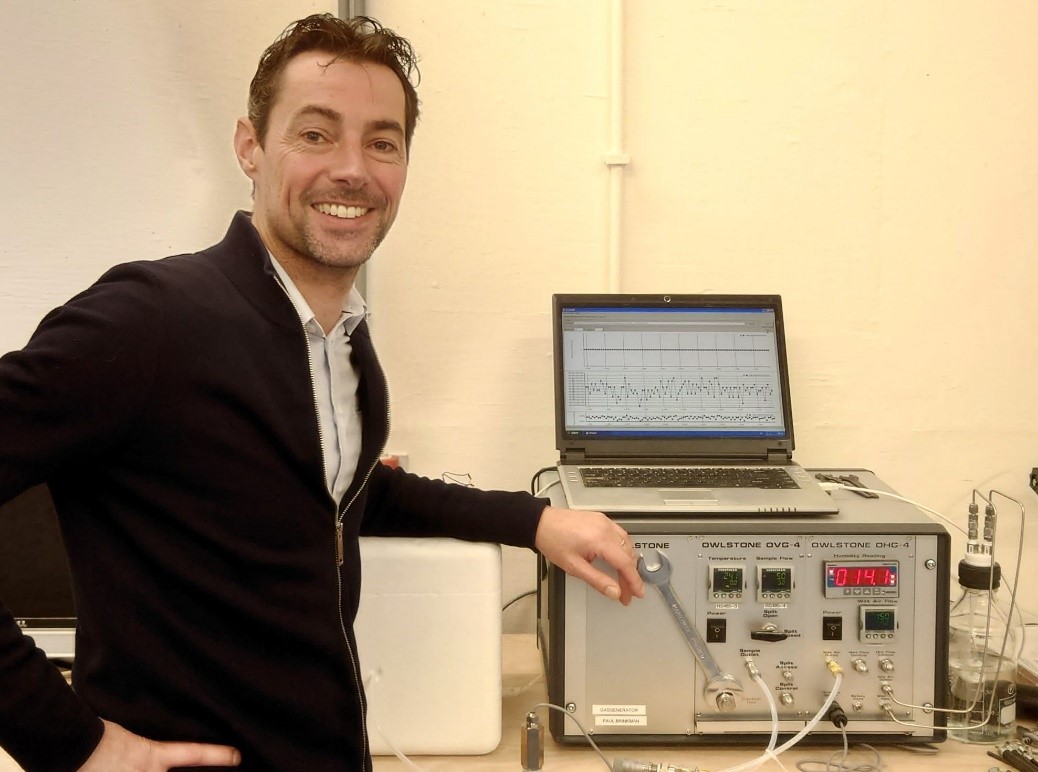Leaders in the Field: Paul Brinkman on bringing breath tests into the home
Published on: 21 Nov 2022
 For this new installment in our ‘Leaders in the Field’ interview series we spoke to Paul Brinkman, Research Associate in the field of Pulmonology at the Amsterdam UMC. With a background in biomedical engineering, Paul’s been working on breathomics for over a decade. Pioneering breath research professor Peter Sterk was a strong early influence.
For this new installment in our ‘Leaders in the Field’ interview series we spoke to Paul Brinkman, Research Associate in the field of Pulmonology at the Amsterdam UMC. With a background in biomedical engineering, Paul’s been working on breathomics for over a decade. Pioneering breath research professor Peter Sterk was a strong early influence.
Paul has specialized in exhaled volatile organic compounds (VOCs) measured with both GC-MS and electric nose (eNose) technology. He is a listed author on close to 100 articles published in peer reviewed journals. He is the Project Lead for ONELAB (Orchestrating next-generation mobile modular laboratories for pandemic monitoring preparedness).
Browse more interviews in this series
How would you describe your research area and what drew you to that specialism?
One of my original supervisors, Peter Sterk, introduced me to breath research. He was looking for someone with a more technical background to work on one of his studies. That was in 2011, I was hired as a biomedical engineer to work on U-BIOPRED, an IMI funded project on severe asthma. I’ve stayed in breath research ever since.
Most of my work on exhaled VOCs is about bringing the field closer to a clinical application. I work with both chemical sensor driven eNoses and mass spectrometry based instruments to develop sampling methods and biomarkers. I’m interested in what the relevant molecules are for specific diseases, but also concerned about whether we can actually develop those into a tool that can be applied at the doctor’s office, or even in a patient’s home.
You’ve mentioned you use both eNoses and mass spectrometry. What are the relative strengths of each approach?
I think mass spectrometry techniques allow us to discover the novel targets and mechanistic pathways which are needed as we work towards the development of non-invasive, VOC based biomarkers. On the other hand, if you look at the cost and complexity of a mass spectrometer, such technologies are not suitable for regular daily care. If you want to bring exhaled VOC analysis into the doctor’s office, or the patient’s home, then we need a technology that’s much cheaper. This is where sensor technology can play a role.
“It’s important to know whether exhaled metabolites originate from bacteria, an inflammatory response, or something else. That’s why we’re culturing bacteria and cells, and studying VOCs that originate from those cultures. The findings of these in vitro studies are subsequently validated in in vivo models […]”
What do you think has been the top three advances in the field over the last five years?
I think there have been two big changes that are quite closely linked. The first has been the return of efforts to link in vitro and in vivo analysis. If you spoke with experts in the field about 10 years ago, then most of them would say: ‘We will not be able to link any of our in vitro results to in vivo results’. The second change is the increased interest in targeted VOC analyses instead of the more open discovery studies. These days there is quite a lot of literature about VOCs available, but developing strategies and pipelines to confirm reported VOCs as potential biomarkers is very much needed.
It’s important to know whether exhaled metabolites originate from bacteria, an inflammatory response, or something else. That’s why we’re culturing bacteria and cells, and studying VOCs that originate from those cultures. The findings of these in vitro studies are subsequently validated in in vivo models, bringing the two advances I’ve mentioned together.
I think the third change I’ve noticed is a slight move away from collecting cross-sectional breath measurements towards longitudinal measurements. The diversity of VOCs you’ll see through cross-sectional measurements is enormous, but you can use longitudinal measurements to identify VOCs where the dynamics follow certain alterations, such as a flare up of inflammation or a change in therapy. That allows you to more easily filter out noise and develop a biomarker that can be used for monitoring purposes.
How many VOCs are actually on exhaled breath as opposed to in the background and how can we know?
The easy answer to this question is everything we exhale is in the environment as well – there is always a mixture between background and what we exhale. But, the latest review papers state that around 1,000 exhaled VOCs have been identified so far. Of course, not all those compounds originate from the human lungs or systemic inflammation. I think it’s very relevant that we determine which VOCs are related to medication or drugs, to pollution and environmental circumstances. Longitudinal studies are important for this purpose, as they can teach us more about regular, daily fluctuations of metabolites.
When did you first become aware of Owlstone Medical and in what context?
Quite a long time ago, working with Peter Sterk, we made use of a Lonestar, which was integrated within our eNose platform. That allowed us to compare directly the data obtained from the Lonestar with data from eNoses and other sensor driven devices. I think this was in 2010 or 2011. Now we’re currently working together within the 3TR consortium, and I still use one of Owlstone’s OVG gas generators (pictured below).

I understand that you’ve been developing your own breath sampler, could you tell us a little bit about that process?
We want to bring breath analysis technology into the patient’s home, with the ability to monitor VOCs for diseases like cystic fibrosis, or COPD. However, it is challenging to compare data obtained at location A with data obtained at location B, using chemical sensor technologies, because of the local circumstances such as room temperature or type of room where the instrument is positioned. That is why we’re focusing on developing sampling and analysis strategies that are suitable for self-assessment at home. Collecting a breath sample should be as easy as: see one, do one, teach one.
Cross sensitivity of sensors is another crucial aspect. At the moment, if you buy a sensor online that is sensitive to ethanol, the odds are quite high that it will respond to a broad range of VOCs. Put that sensor in a home monitoring tool and you’d not be certain if you were measuring your VOC of interest or another interfering compound. What we’ve developed is a benchmarking platform that allows you to expose all kinds of sensors to your VOCs of interest, and directly compare their performance. This allows us to have the optimal selection of sensors per disease, but also to assess the lower limit of detection of those sensors. We’re really trying to push things, in order to get this technology into the patient’s home.
Your new project ONELAB, sounds exciting. What are you working to acheive?
ONELAB is a pan-European project, that includes 22 international partners and is funded through the Horizon Europe Programme and UK Research and Innovation. It is funded based on the Disaster-Resilient Society 2021 call for applications. We will focus on designing and coordinating mobile laboratory operations for the detection and identification of infectious agents. It concerns the development of a rapid biomarker discovery workflows, translation of involved technology into modular mobile laboratory test capability and finally a consensus-driven concepts of operation for these labs. Within the next three years our consortium, which consists of basic scientists, clinical sites, SMEs, local authorities and end users, will design, build and test next-generation mobile modular laboratories.
“I expect that within five years from now, we will have isolated a solid set of VOCs that enables differentiation between bacterial infections.”
What changes do you see coming in the next five years for breath research?
I see more and more initiatives that aim to improve international collaboration. Currently every new review on exhaled breath says: ‘we are a field that is still developing and that’s causing issues with standardization’. At the moment we often cannot easily compare data from one study to another, so I think that the field is heading towards further standardization.
Five years ago, the question was ‘will the device that you’re developing now, be on the market within five years?’ and the answer was always ‘Yes’. However, we’re not there yet. It turns out that five years is not that long! I expect that within five years from now, we will have isolated a solid set of VOCs that enables differentiation between bacterial infections. Furthermore, I think we will have much more longitudinal data available, which will enable us to follow-up VOCs over time and to learn about daily (within patient) fluctuations. And, I do think that the first relevant exhaled VOC based point-of-care tools, will be here within five years.
Recent papers/initiatives where Paul Brinkman is involved:
- www.onelab-project.eu
- Targeted exhaled breath analysis for detection of Pseudomonas aeruginosa in cystic fibrosis patients
- Microbial volatiles as diagnostic biomarkers of bacterial lung infection in mechanically ventilated patients
- Exhaled volatile organic compounds as markers for medication use in asthma
This blog post is part of our ongoing series of in-depth interviews with influential leaders currently working in breath research. Other ‘Leaders in the Field’ interviewees have included Professor Richard Yost, inventor of the triple quadrupole mass spectrometer, Salman Siddiqui, a specialist in breath testing for inflammatory respiratory diseases, and Anke-Hilse Maitland-van der Zee, President of the Federation of Innovative Medicine Research in the Netherlands